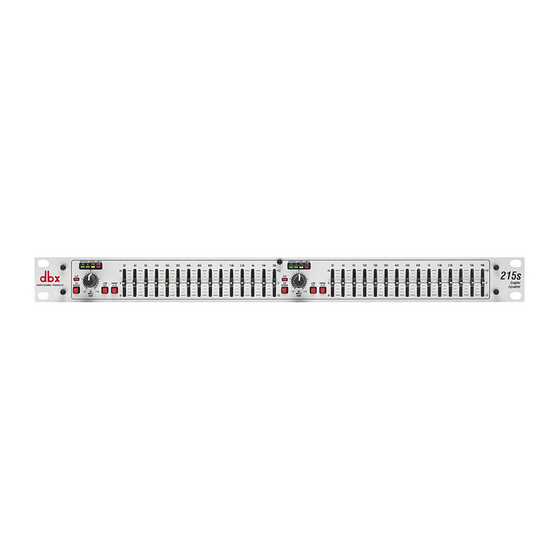dbx 215s Gebruikershandleiding - Pagina 10
Blader online of download pdf Gebruikershandleiding voor {categorie_naam} dbx 215s. dbx 215s 12 pagina's. 2-series graphic equalizers
Ook voor dbx 215s: Kenmerken (2 pagina's)

2-Series
User Manual
A balanced line is defined as two-conductor shielded cable with the two center conduc-
tors carrying the same signal but of opposite polarity when referenced to ground. An
unbalanced line is generally a single-conductor shielded cable with the center conductor
carrying the signal and the shield at ground potential.
Input Cable Configurations: The equalizer has an input impedance of 40 k
balanced
and 20 k
unbalanced. This makes the 2-Series Equalizers' audio inputs suitable for use
with virtually any low source impedance (under 2 k ).
Output Cable Configurations: The equalizer's output is capable of driving down to a
2 k
load to at least +21 dBu. For maximum hum rejection with a balanced source,
avoid common grounding at the equalizer's inputs and outputs. Most balanced (3-con-
ductor) cables have the shield connected at both ends. This can result in ground loops
which cause hum. If hum persists try disconnecting the shield on one or more of the
cables in the system, preferably at the input of a device, not at the output.
Section 6 - Operation and Application Notes
The dbx 2-Series Graphic Equalizers are useful audio signal processing tools in situations
where precise frequency control is required across the audible frequency spectrum.
When used with an audio spectrum analyzer the EQs can tune any acoustical environ-
ment -- from the studio to the concert hall -- to stop ringing, increase clarity, and tailor
the overall frequency response of the environment. A real-time spectrum analyzer or
other types of audio environment analyzers are very useful in determining the amount of
equalization needed.
Insert the graphic equalizer between the signal source (usually a mixer) and the power
amplifiers (or the crossover if there is one). Adjust the level and equalization as
required to yield the desired system response.
For optimum signal-to-noise response, the gain structure of the sound system must be
properly set up. Each component of the sound system should be set at its nominal oper-
ating level, starting with the first element in the system, usually a mixing console. Each
element should be run at its nominal operating level in order to take advantage of the
maximum signal-to-noise properties of that element. Loudspeaker amplifiers, as the last
element in the chain, should be set only as loud as necessary, in order to avoid inducing
unnecessary noise into the system.
10
